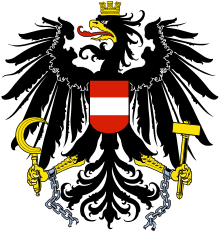Supreme Court (Austria)
| Supreme Court | |
|---|---|
| Oberster Gerichtshof | |
|
Palace of Justice, Vienna | |
| Established | 1848 |
| Country | Austria |
| Location | Vienna |
| Coordinates | 48°12′23″N 16°21′26″E / 48.20639°N 16.35722°ECoordinates: 48°12′23″N 16°21′26″E / 48.20639°N 16.35722°E |
| Authorized by | Austrian Federal Constitution |
| Number of positions | 58 |
| Website |
ogh |
The Supreme Court (German: Oberster Gerichtshof, OGH) is one of three judicial bodies charged with final appellate jurisdiction in Austria. Whereas the Constitutional Court deals with constitutional law and the Supreme Administrative Court with public law, the Supreme Court is the highest instance in private and criminal law matters. These three Courts are hierarchically on the same level, there being no superiority or subordination between them.
The Court meets in the Palace of Justice in Vienna.
History

 |
| This article is part of a series on the politics and government of Austria |
| Constitution |
| Judicial system |
| Foreign relations |
The Austrian Supreme Court was established in the course of the March Revolution by ministerial decree on 21 August 1848. It succeeded the Highest Judicial Office (Oberste Justizstelle), the common justice department and supreme court of the Austrian hereditary lands and the Lands of the Bohemian Crown that had been founded under the reign of the Habsburg empress Maria Theresa in 1749. The Court received its organisational structure by edict of Emperor Franz Joseph I in 1850, with Count Louis Taaffe (1791–1855) as its first president. It then had jurisdiction over all crown lands of the Austrian Empire.
By the Austro-Hungarian Compromise of 1867 and the December Constitution, the Supreme Court had remained the highest judicial body in the Cisleithanian lands, though not of the Lands of the Crown of Saint Stephen under jurisdiction of the Hungarian Curia Regia. The Basic Law on the Judiciary (Staatsgrundgesetz über die richterliche Gewalt)[1] stipulated the separation of administration and judiciary and the independence of the courts. From 1865 to 1891, the liberal statesman Anton von Schmerling served as court president. Important legal reforms included the criminal code of 1873 and the implementation of the Civil procedure code in 1895.
After World War I and the dissolution of the Austro-Hungarian monarchy, the Supreme Court by law became the court of last resort for civil and criminal proceedings in the territory of German Austria, and the highest court according to the 1920 Constitution of the First Austrian Republic. The political turmoils during the inter-war period culminated in the Vienna Palace of Justice fire (Wiener Justizpalastbrand) on 15 July 1927, whereby large parts of the building were devastated. During the Austrian Anschluss to Nazi Germany from 1938 to 1945, the OGH's jurisdictions were transferred to the Reichsgericht (Imperial Court) in Leipzig.
After World War II the Austrian sovereign statehood was restored and the Supreme Court re-established. Since 1969 its jurisdiction is exercised on the legal basis of the Federal Supreme Court Act.
See also
References
External links
- Supreme Court of Justice official website
